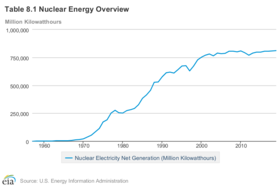In the United States, nuclear power is provided by 94 commercial reactors with a net capacity of 97 gigawatts (GW), with 63 pressurized water reactors and 31 boiling water reactors.[1] In 2019, they produced a total of 809.41 terawatt-hours of electricity,[2] and by 2024 nuclear energy accounted for 18.6% of the nation's total electric energy generation.[3] In 2018, nuclear comprised nearly 50 percent of US emission-free energy generation.[4][5]
As of September 2017,[update] there were two new reactors under construction with a gross electrical capacity of 2,500 MW, while 39 reactors have been permanently shut down.[6][7] The United States is the world's largest producer of commercial nuclear power, and in 2013 generated 33% of the world's nuclear electricity.[8] With the past and future scheduled plant closings, China and Russia could surpass the United States in nuclear energy production.[9]
As of October 2014,[update] the Nuclear Regulatory Commission (NRC) had granted license renewals providing 20-year extensions to a total of 74 reactors. In early 2014, the NRC prepared to receive the first applications of license renewal beyond 60 years of reactor life as early as 2017, a process which by law requires public involvement.[10] Licenses for 22 reactors are due to expire before the end of 2029 if no renewals are granted.[11] Pilgrim Nuclear Power Station in Massachusetts was to be decommissioned, on June 1, 2019. Another five aging reactors were permanently closed in 2013 and 2014 before their licenses expired because of high maintenance and repair costs at a time when natural gas prices had fallen: San Onofre 2 and 3 in California, Crystal River 3 in Florida, Vermont Yankee in Vermont, and Kewaunee in Wisconsin.[12][13] In April 2021, New York State permanently closed Indian Point in Buchanan, 30 miles from New York City.[13][14]
Most reactors began construction by 1974; following the Three Mile Island accident in 1979 and changing economics, many planned projects were canceled. More than 100 orders for nuclear power reactors, many already under construction, were canceled in the 1970s and 1980s, bankrupting some companies.
In 2006, the Brookings Institution, a public policy organization, stated that new nuclear units had not been built in the United States because of soft demand for electricity, the potential cost overruns on nuclear reactors due to regulatory issues and resulting construction delays.[15]
There was a revival of interest in nuclear power in the 2000s, with talk of a "nuclear renaissance", supported particularly by the Nuclear Power 2010 Program. A number of applications were made, but facing economic challenges, and later in the wake of the 2011 Fukushima Daiichi nuclear disaster, most of these projects have been canceled. Up until 2013, there had also been no ground-breaking on new nuclear reactors at existing power plants since 1977. Then in 2012, the U.S. Nuclear Regulatory Commission approved construction of four new reactors at existing nuclear plants. Construction of the Virgil C. Summer Nuclear Generating Station Units 2 and 3 began on March 9, 2013, but was abandoned on July 31, 2017, after the reactor supplier Westinghouse filed for bankruptcy protection in March 2017.[16] On March 12, 2013, construction began on the Vogtle Electric Generating Plant Units 3 and 4. The target in-service date for Unit 3 was originally November 2021.[17] In March 2023, the Vogtle reached "initial criticality" and started service on July 31, 2023.[18][19] On October 19, 2016, Tennessee Valley Authority's Unit 2 reactor at the Watts Bar Nuclear Generating Station became the first US reactor to enter commercial operation since 1996.[20]
- ^ "Nuclear Power in the USA".
- ^ "U.S. nuclear industry – U.S. Energy Information Administration (EIA)". EIA.gov. Retrieved April 24, 2020.
- ^ "Electricity in the U.S. – U.S. Energy Information Administration (EIA)". EIA.gov. Retrieved November 14, 2024.
- ^ "Carbon Dioxide Emissions Avoided". September 30, 2022.
- ^ Cho, Adrian (May 20, 2020). "U.S. Department of Energy rushes to build advanced new nuclear reactors". Science. Retrieved October 20, 2020.
Commercial nuclear reactors supply 20% of the United States's electrical power and 50% of its carbon-free energy.
- ^ "PRIS – Country Details". International Atomic Energy Agency. Retrieved October 21, 2016.
- ^ "Nuclear Energy Overview". EIA. Retrieved April 29, 2015.
- ^ "International energy statistics – Nuclear Electricity Net Generation by Country". US Energy Information Administration. Retrieved April 18, 2015.
- ^ DiChristopher, Tom (March 21, 2019). "The US is losing the nuclear energy export race to China and Russia. Here's the Trump team's plan to turn the tide". CNBC. Retrieved April 25, 2020.
- ^ "Preparing for licensing beyond 60 years". World-Nuclear-News.org. February 24, 2014. Archived from the original on January 4, 2016. Retrieved July 6, 2016.
- ^ "Nuclear Regulatory Commission resumes license renewals for nuclear power plants". EIA. October 29, 2014. Retrieved April 28, 2015.
- ^ Cooper, Mark (June 18, 2013). "Nuclear aging: Not so graceful". Bulletin of the Atomic Scientists.
- ^ a b Wald, Matthew (June 14, 2013). "Nuclear Plants, Old and Uncompetitive, Are Closing Earlier than Expected". The New York Times.
- ^ "Lower power prices and high repair costs drive nuclear retirements – U.S. Energy Information Administration (EIA)". www.eia.gov. Retrieved June 11, 2024.
- ^ "The Political Economy of Nuclear Energy in the United States" (PDF). Social Policy. The Brookings Institution. 2004. Archived from the original (PDF) on November 3, 2007. Retrieved November 9, 2006.
- ^ "Two Half-Finished Nuclear Reactors Scrapped as Costs Balloon". Bloomberg.com. July 31, 2017. Retrieved September 26, 2020.
- ^ "Eighteenth Semi-Annual Vogtle Construction Monitoring Report" (PDF). GeorgiaPower.com. February 2018. Retrieved April 3, 2018.
- ^ "Vogtle Unit 3 reaches initial criticality". Georgia Power. Retrieved March 7, 2023.
- ^ "Nuclear explained: U.S. nuclear industry". US Energy Information Administration. August 24, 2023. Retrieved October 17, 2023.
- ^ Blau, Max (October 20, 2016). "First New US Nuclear Reactor in 20 Years Goes Live". CNN. Retrieved October 20, 2016.



